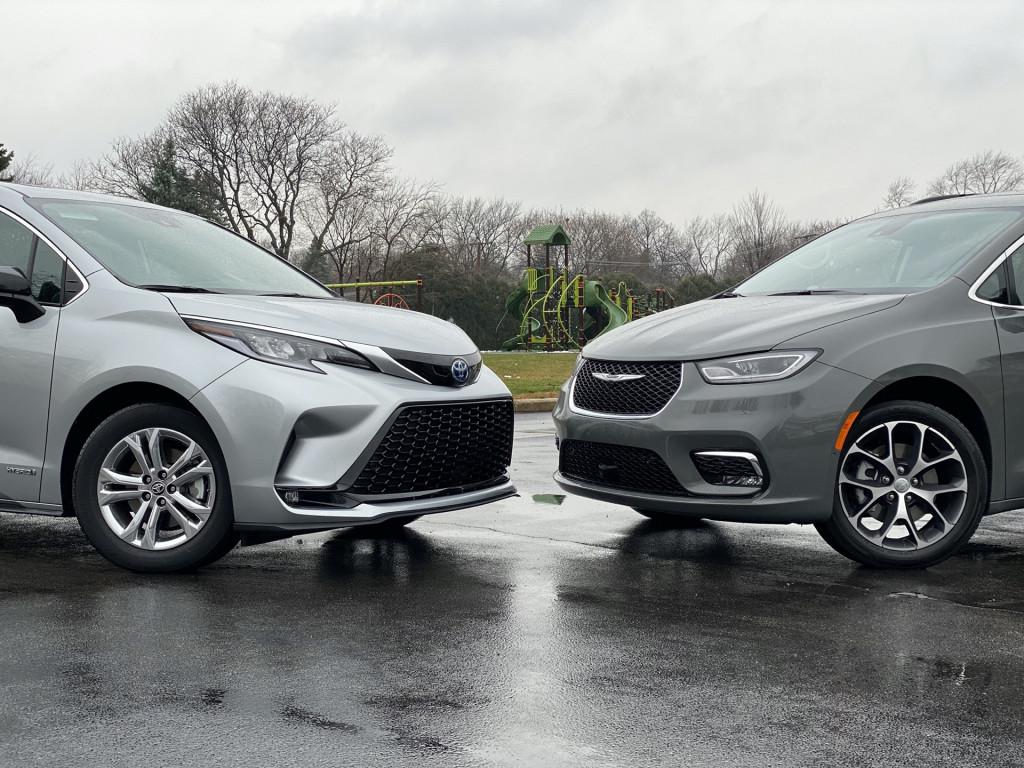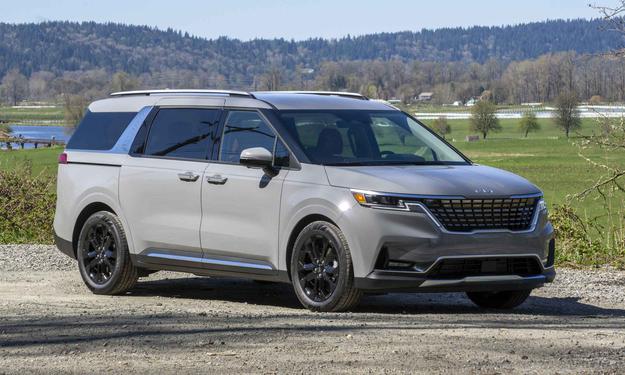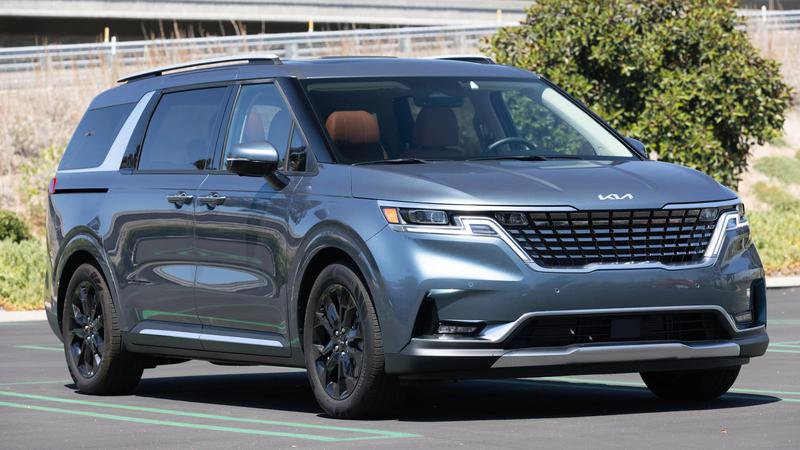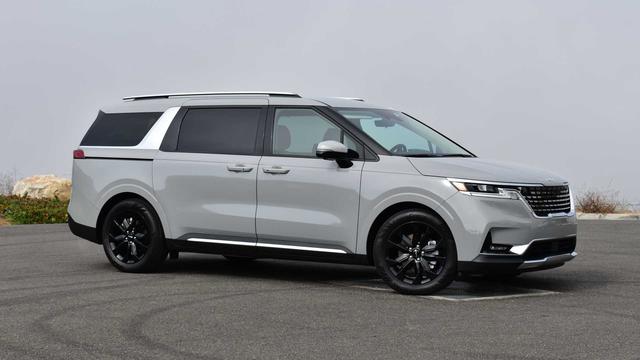Auto123 pits the 2021 Toyota Sienna and 2021 Chrysler Pacifica Hybrid against one another in a head-to-head comparison.
The minivan, it has to be said, is making a bit of a resurgence these days.
After losing market share year after year to three-row crossovers and SUVs, minivans have adapted to try and maintain a sub-niche in the people-mover sector. First, folks were buying SUVs and crossovers because they looked better than minivans, so minivan designers started upping their game. Second, buyers liked the powertrain variety provided by SUVs and CUVs, so minivan makers like Toyota and Chrysler started providing hybrid powertrains.
Which brings us to the Pacifica and Sienna, both available with AWD, although only the Toyota can be hybridized and get AWD at the same time. That’s going to be a boon for many drivers.
Shopicar.com, 100% online, shop for your next car, buy online and get it delivered to you anywhere in Quebec!
2021 Toyota Sienna
Photo: D.HeymanToyota Sienna
The big-selling Sienna is all-new for 2021, from the powertrain to the styling and so on. It starts at $39,990 but can stretch all the way to $58,445 in Limited spec (seen here). The one thing all Siennas get, however, is a hybrid powertrain.
Stylistic leap
The styling change is most easily seen…well, everywhere. The front fascia gets new headlights and an aggressive lower splitter, while the rear is defined by headlights that are actually inspired by the GR Supra sports car. Yep. You could also argue that the flares over the rear fenders take their cues from that model. It’s a pretty unique way to style your people mover.
But then, there’s only so much you can do when it comes to styling a van. Ask any designer, they’ll tell you that while the truck and SUV formats are tough nuts to crack when it comes to adding uniqueness, minivans aren’t far behind. But Toyota has turned the neat trick of designing a pretty cool-looking van. Especially if you opt for the bright Ruby Flare Pearl (red) finish. Not only does it look a little like a Supra, but it can be coloured like one, too!
One thing I’d like is a little more variety when it comes to wheel choice. To be precise, I’d like any amount of variety, because, well, there isn’t any. Wheels are linked to whichever trim you go with, and there’s one style for each. Personally, I’m a fan of the smoked dark wheels you get with the XSE model – but only on the front-wheel drive XSE model, though there is an AWD model available. The 18-inch items I had on my tester don’t have much of a design, and they’re dwarfed by the big panels surrounding them.
I do love those fender flares, though. Can’t remember the last time I saw a minivan sport a set of those.
Photo: D.HeymanToyota Sienna, second-row seats
Step into my cavern!
If there’s one thing about the Sienna, it’s that you know that you’re in a very, very large space soon as you step inside. All the surfaces are nicely flared so as to not infringe on occupant space, and there’s a real sense of airiness.
The dividing surface between the upper and lower dash sections that arcs from the passenger to the driver side is an example, as are the massively wide centre console and the broad door panels. All subtly rounded and able to open up the interior environs. Perhaps more impressive still when it comes to the centre console is the large opening underneath, big enough for smallish duffel bags.
It's not just about the actual measured space, either, but how well it’s all put to use. Every time you think about storing something, it’s as if a bin, a shelf, or a cupholder or other type of container just appears magically at your fingertips. Like the shelf that runs the width of the dash in front of the passenger, which puts the space left by that arched panel above to good use and is sized for smartphones. Then there’s the great central armrest, actually two armrests flanking a centralized storage lid so the driver doesn’t lose their armrest if the front passenger needs to access the bin. So simple but so smart; Toyota is good at this minivan game.
I do hesitate about whether I prefer the second-row captain’s chairs as seen here, or the three-person bench you can also get for your Sienna. The chairs are surely more comfortable for occupants and they make accessing the rear seat a little easier, but with their armrests and all of that, they do add some clutter and more spots to snag stuff on. Really, in this spec, the Sienna may be best for those who want to maintain the luxury they once had in their sedan or SUV.A plus is that they can individually slide fore and aft and can be had with footrests if you desire; the same can’t be said for the Pacifica.
Photo: D.HeymanToyota Sienna, third-row seats
The third row is plenty roomy – which is great – but the way the seats collapse into the floor is ungainly, takes too much effort and too many steps and feels kind of cheap in its action. There were times I wasn’t sure the seat was fully stowed because the “click” to confirm this just wasn’t prominent enough. Regarding this element, Toyota could learn from what Chrysler offers in its Pacifica.
Speaking of sliding, the Sienna comes with power sliding doors at base, which is great for convenience in most cases, especially since they can be opened or closed via the keyfob or by swinging your foot underneath them on all but the base LE trim. But I’m less enthused that you have to look up above the driver’s seat to find the buttons used for opening and closing the doors from the inside. It’s just less intuitive. Also, some out there might prefer a manual sliding door; if that’s you, the power doors can be turned off with a simple press of a button mounted at the driver’s left knee.
Hybrid always, AWD sometimes
The only way you can get a Sienna is with Atkinson Cycle hybrid power, to the tune of 245 hp and between 175 and 199 lb-ft torque from a 2.5L 4 cylinder and two EV motors (in AWD Siennas). That torque delivery is dependent on how much of the dual EV motors are being put to use, which varies depending on how much power the battery has, the nature of the road you’re on (are you climbing? Is it slippery?) and which of the on-board accessories you’re making use of.
There’s also a button for an EV mode that asks the EV motors to keep working just a little longer than normal, but the bandwidth is so thin, I barely used it and indeed, it should be reserved for use in tight rush-hour traffic.
Photo: D.HeymanToyota Sienna, three-quarters rear
Beyond that, I did feel the Sienna to be quite heavy when asked to go beyond its comfort zone (at speed on the highway). You can really hear the engine and CVT automatic straining when pushed, which is all the more striking because everything else about the Sienna drive experience is about serenity and comfort. So when you hear that engine huff and puff – and you will – it’s quite jarring.
Of course, the fact that I had the full-load version with AWD means there’s the extra weight of the AWD system – hence the second EV motor - to haul around. That pushes the weight up over 2,000 kg, and when you’ve got less that 200 lb-ft of torque to work with at the best of times, you will feel that weight. Fuel economy, meanwhile, is rated at 6.8/6.6/6.7L/100 km city/highway/combined - not bad for a vehicle as hulking as this, and far better than what you’ll get from the Pacifica’s V6.
2021 Chrysler Pacifica
Photo: D.HeymanChrysler Pacifica hybrid
Like the Sienna, the Pacifica can be had with either FWD or AWD, but here, if you want AWD, the hybrid version isn’t going to be an option. Also unlike the Sienna – which a straight-up hybrid -- the Pacifica is a plug-in (PHEV), meaning you can actually get some all-EV driving under your belt, to the tune of about 51 km if you’re in low-stress environments, like city driving on temperate days. Pricing for the Pacifica Hybrid ranges from $49,192 to $55,648.
Wait…that’s a minivan?
I remember when I attended my first European auto show and was impressed by how many of the European manufacturers – mostly from France – were able to so well disguise the fact that their minivans were in fact minivans. Aggressively-slanted front ends, smart side window design and neat touches like roof spoilers made their vans look far more chiseled – almost handsome – than those in North America. One reason is that minivans had the task of replacing station wagons in Europe much later than they did in North America, and that means you couldn’t just deliver some bulbous thing and call it a day. European buyers wouldn’t have it.
Seems that Chrysler has taken that to heart with the Pacifica, a suave looking thing. The way the side windows taper forwards towards the back and the well-shaped snout all provide a profile that looks more “big station wagon” - just as the Europeans have always done.
It's in the details, too. Tthe full taillight bar across the back and foglights up front are all very sporting, while the chrome detailing on the Pinnacle script behind the front wheels, stripping around the side windows and on the wing mirrors is a great callback to the super chromed American cars of old. It provides a much more compact look than does the Sienna, even though the Pacifica is actually the wider of the two. Add the tinted windows and almost candied red paint on my tester, and this is one good-looking minivan.
Photo: D.HeymanChrysler Pacifica hybrid, interior
Interior DeLuxe
The same goes for the interior, which makes great use of lighting and top-class materials to make its point. Not to mention the gingerbread house-like finish and diamond quilting on the seats, which is a very luxurious touch.

It also gets Chrysler’s massive 10-inch Uconnect display with great graphics that make the Sienna’s system seem pedestrian in comparison. Uconnect is also very intuitive, with configurable shortcuts strung across the display for all your most used apps and features. The touchscreen is very responsive, and the buttons large enough that finding them in your peripheral while driving is rarely a problem.
It's also on this display that you’ll find one of my favourite features: appropriately (and affectionately) called “FamCam” (and unfortunately only available on the top-spec Pinnacle trim). It basically provides a bird’s eye view of what’s going on in the first and second rows. If your child picks their nose – even at night, as there is a night vision-esque quality to it – you will see it. It doesn’t work as well for reverse-facing car seats, but the fisheye style mirror you also get, combined with a third-party mirror attached to the rear headrest does a good job of showing you what you need.
On my tester, the second row captain’s chairs, meaning there’s no Stow N’ Go seating there and the only way to remove the second row – like in the Sienna – is to literally lift the seats out. It’s too bad, but the third row is Stow N’ Go so it’s far easier to fold than the third row in the Sienna. It also means that if the third row is in use, you have an ultra-deep bin behind them for your wares.
Chrysler Pacifica hybrid, second-row seats
Now the flip side. The Pacifica looks big car-like from the exterior, and… it feels more car-like inside as well. It’s more luxurious cozier than the Sienna, but there isn’t nearly the storage capability that the Toyota has. I do like how all main controls – including the shift-selector wheel – are placed on a nice ledge at the base of the centre stack, but I the only storage you really have there is a traditional bin in the armrest (yes, you have to move the whole armrest to open the lid) and fairly cramped bin at the base of the centre stack. There are a couple of cupholders, too, but the Sienna has more.
Let’s glide
You can dress up an interior all you want, but if the ride doesn’t back it up, then it’s a bit of a case of “all show, no go”. Luckily, that is not a problem with the Pacifica as it rides very much like the luxury vehicle it looks to be.
Everything but the harshest bumps are gamely absorbed by the chassis and well-tune dampers, to the point where it almost feels like they’re adaptive, which they are not. It’s a standard MacPherson strut front/trailing arm rear set-up, but it all comes together nicely to make for a luxury-like ride. Indeed, if there’s one thing Chrysler knows, it’s how to make their cars ride well. Body roll through corners is kept nicely in-check as well, which is important when you have so many occupants and increased chance of motion sickness.
When it comes to power, the Pacifica is the clear-cut winner. Its 3.6L Pentastar V6 plus EV motor is good for 260 hp, so speed off the line is brisk and I never found myself wanting for more power when freeway passing. The Pacifica is the heavier vehicle, but power more than makes up for it. I never stressed the powertrain like I did with the Sienna, even though both use a similar CVT-style electronically variable transmission.
The steering is also very good. As you’d expect from a minivan, often found on clogged city streets and parkades, the wheel can be turned with little more than an outstretched digit. That makes it easier to work with and has it feeling more luxurious all at the same time.
The most ground I could cover in EV mode was about 37 km, less than what Chrysler claims. But of course, the Pacifica can be plugged in at night so if you’re using it mainly for a weekday school run commute or soccer practice, then you could be spending most of your time in EV mode. Which is the polar opposite to the “EV mode” you get with the Sienna.
Photo: Chrysler / ToyotaChrysler Pacifica hybrid / Toyota Sienna
Advantage Toyota Sienna
When it comes to interior ergonomics, the Sienna wins, and would do so in more dominant fashion were it not for the awkwardness associated with folding the third row. From the plentiful storage surfaces and bins, to that great central armrest and throne-like driver’s seating position, this is a great vehicle in which to spend many consecutive hours. Which, because it’s a minivan, owners tend to do.
Advantage Chrysler Pacifica
The Uconnect infotainment is a big step up over what the Sienna offers. From the great graphics to the intuitive interface to the quality of the thin screen and how it integrates into the dash, and of course that great FamCam, the Pacifica takes the cake in this regard.
Similarities
While these are very differently-styled minivans, they’re both good-looking in their own way. Whether you like the futuristic looks of the Sienna or more low-profile and car-like look of the Pacifica, you can’t really go wrong either way with these.
Verdict
Here are two minivans that are very good at what they’re meant to do. The Chrysler traces its roots all the way back to the original people-moving minivan of the late ‘70s; the Sienna is one of the leading models in the segment not made by a North American manufacturer. Both carry the minivan flag very well.
But we do have to pick one, here, and in the end, I’m turning to the Pacifica. With the Stow N’ Go seating, the infotainment, the fact it’s a plug-in hybrid and those luxurious interior digs and luxurious ride, the Pacifica is a fantastic choice. Yes, if you want AWD, you have to forego the hybrid powertrain but the fact that you have the choice is compelling. The new Sienna is very, very good. The Pacifica is just that much better.
Photo: D.HeymanToyota Sienna / Chrysler Pacifica hybrid
2021 Toyota Sienna
We like
AWD
Interior storage
Good ergonomics
We like less
Gutless engine
Infotainment needs updating
2021 Chrysler Pacifica Hybrid
We like
Gorgeous interior digs
Handsome looks
Plug-in hybrid power
We like less
Could use more interior storage
No hybrid/AWD combo
Photo: D.HeymanChrysler Pacifica hybrid / Toyota Sienna, three-quarters rear
Specifications
| .. | | Toyota Sienna | Chrysler Pacifica hybrid |
| | Transmission | CVT | CVT |
| | Drivetrain | FWD/AWD | FWD |
| | | | |
| | | FWD | |
| | Fuel Consumption (city) | 6.6L/100 km | 8.0L/100 km |
| | Fuel Consumption (hwy) | 6.5L/100 km | 7.9L/100 km |
| | Fuel Consumption (combined) | 6.5L/100 km | 8.0L/100 km |
| | | AWD | |
| | Fuel Consumption (city) | 6.8L/100 km | |
| | Fuel Consumption (hwy) | 6.6L/100 km | |
| | Fuel Consumption (combined) | 6.7L/100 km | |
| | | | |
| | Engine | | |
| | Type | gas/hybrid | gas/hybrid |
| | Output | 245 hp | 260 hp |
| | Torque | 175 - 199 lb-ft | 184 lb-ft |
| | Cylinders | 4 | 6 |
| | Displacement | 2.5L | 3.6L |
| | | | |
| | Capacities | | |
| | Cargo space | 949 l / 2860 l | 914.6 l / 3979 l |
| | Fuel tank | 68 l | 62.5 l |
| | | | |
| | Dimensions | | |
| | Length | 5175 mm | 5189 mm |
| | Width | 1994 mm | 2022 mm |
| | Height | 1776 mm | 1777 mm |
| | Wheelbase | 3061 mm | 3089 mm |
| | | | |
| | Warranty | 3 yrs/60,000 km | 3 yrs/60,000 km |
| | | | |
| | Price (as tested) | $58,445 | $55,648 |
| | | | |
| | | | |




